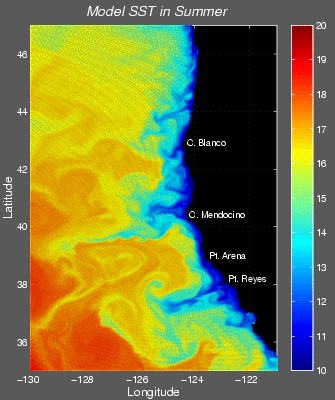|


UCLA
ROMS
U.S.
West Coast Model
Over the last five years, part of the CESR
group developed a unique simulation and modeling code. This code accounts
for the many scales that must be considered when studying broad ocean phenomena,
as well as coastal circulation systems. Called the Regional Oceanic Modeling
System (ROMS), the code is used at UCLA and at several
other places. Most of the various numerical pieces (computation kernel,
realistic vertical mixing parametrization model, robust boundary conditions
adapted to long-term integrations, variable biogeochemistry model, sediment
model and Lagrangian capability) were fit together in ROMS. We are now in
a position to be able to study any regional coastal system and how it and
global systems influence each other. We are running ROMS simulations
on NCSA's supercomputers, using several hundred thousand hours of computation
time each year. [UCLA ROMS group photo includes, back row: Xavier Capet,
Alexander Shchepetkin, Hartmut Frenzel, Keith Stolzenbach, and Olaf Haupt;
front row: Patrick Marchesiello, James McWilliams, and Nicolas Gruber.]
The U.S. West Coast (USWC) Model
Our initial goal has been to create an accurate
model of the North American West Coast (NAWC) regional system and to perform
realistic long-term integrations of the California Current System (CCS).
Solutions in statistical quasi-equilibrium have been obtained and analyzed
to unravel the intricate dynamics of the CCS. Similarly, a description
of the CCS ecosystem quasi-equilibrium is underway.
Toward the Smaller Scales : Grids Embedded into the
USWC Domain
To cope simultaneously with phenomena that
involve time and length scales with different orders of magnitude (rapid
air temperature and wind changes versus carbon dioxide levels or slow salinity
variations in the water; local circulation patterns influenced by localized
winds, storms, and coastline irregularities versus large scale circulation
strongly tied to broad atmospheric weather systems), we have chosen an approach
based on the nesting of grids with increasingly high resolution. These
nested grids work much like Adaptive Mesh Refinement techniques. A simulation
starts with the coarsest resolution grid (the parent grid) that measures
a mesoscale phenomena. Finer resolution "child" grids are then advanced
by one step with boundary conditions provided an uptodate parent solution.
This goes on as long as child grids exist. The parent grid is then modified
using the information obtained from the child grids, to create a more accurate
model that measures both large- and small-scale events over time. So far,
we have run simulations that use as many as three grid levels off the Central
California Coast and four grid levels off Southern California (with a finest
grid measuring at 500-meter intervals in the Santa Monica Bay). The
high resolution solutions obtained on the highest grid levels allow us to
develop coastal engeneering and water quality applications.
Toward the Larger Scales : Pacific Simulations
In the same spirit of looking at interactions
between different time and length scale dynamics, we began generating
simulations of the circulation (and soon ecosystems and geochemistry)
for the entire Pacific basin and then scaling down those simulations to
examine conditions specific to the NAWC. This work is aimed at a better
understanding of large-scale low frequency climate fluctuations
(e.g., the periodic warming of the sea surface temperature in the tropical
Pacific El Niño Southern Oscillation, also the lower frequency signals
of the Pacific Decadal Oscillation) affect regional currents and
ecosystems.
|

